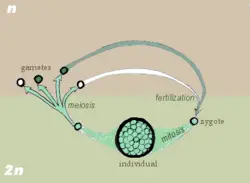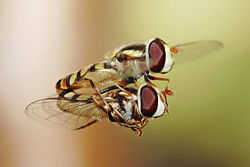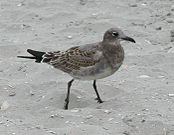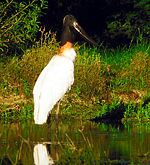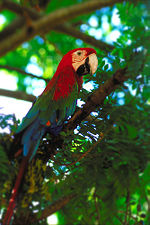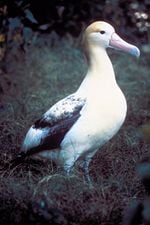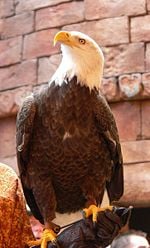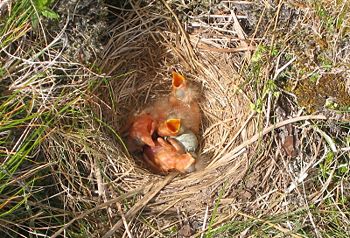Difference between revisions of "Sexual reproduction" - New World Encyclopedia
Rick Swarts (talk | contribs) |
Rick Swarts (talk | contribs) |
||
| Line 9: | Line 9: | ||
[[Image:Hoverflies mating midair.jpg|thumb|250px|Hoverflies mating in midair flight]] | [[Image:Hoverflies mating midair.jpg|thumb|250px|Hoverflies mating in midair flight]] | ||
| − | Sexual reproduction is the primary method of reproduction for the vast majority of visible organisms, including almost all [[animal]]s and [[plant]]s. | + | Sexual reproduction is the primary method of reproduction for the vast majority of visible organisms, including almost all [[animal]]s and [[plant]]s. The origin of sex and the prominence of sexual reproduction are major puzzles in modern [[biology]]. |
| − | |||
| − | The | ||
| − | |||
| − | |||
| − | |||
==Overview: Gametes, meiosis, fertilization, and mitosis== | ==Overview: Gametes, meiosis, fertilization, and mitosis== | ||
[[Image:Sexual cycle.png|thumb|250px|right|In the first stage of sexual reproduction, 'meiosis', the number of chromosomes is reduced from a diploid number (2n) to a haploid number (n). During 'fertilization', haploid gametes come together to form a diploid zygote and the original number of chromosomes (2n) is restored.]] | [[Image:Sexual cycle.png|thumb|250px|right|In the first stage of sexual reproduction, 'meiosis', the number of chromosomes is reduced from a diploid number (2n) to a haploid number (n). During 'fertilization', haploid gametes come together to form a diploid zygote and the original number of chromosomes (2n) is restored.]] | ||
| − | Typically, a gamete or reproductive cell is haploid, while the somatic or body cell of the organism is diploid. A ''diploid'' cell has a paired set of chromosomes. ''Haploid'' means that the cell has a single set of unpaired [[chromosome]]s, or one half the number of chromosomes of a somatic cell. In diploid organisms, sexual reproduction involves alternating haploid (n) and diploid (2n) phases, with fusion of haploid cells to produce a diploid organism. (See [[Life cycle#Sexual reproduction life cycles|life cycle]]) | + | Sexual reproduction involves the fusion or fertilization of gametes from two different sources or organisms. |
| + | |||
| + | Typically, a gamete or reproductive cell is haploid, while the somatic or body cell of the organism is diploid. A ''diploid'' cell has a paired set of chromosomes. ''Haploid'' means that the cell has a single set of unpaired [[chromosome]]s, or one half the number of chromosomes of a somatic cell. In diploid organisms, sexual reproduction involves alternating haploid (n) and diploid (2n) phases, with fusion of haploid cells to produce a diploid organism. (See [[Life cycle#Sexual reproduction life cycles|life cycle]].) Some organisms, however, exhibit polyploidy, whereby there are more than two homologous sets of chromosomes. | ||
Meiosis and mitosis are an integral part of cell division. Mitosis occurs in somatic (body) cells. The resultant number of cells in mitosis is twice the number of original cells. The number of [[chromosome]]s in the daughter cells is the same as that of the parent cell. ''Meiosis'' occurs in reproductive or sex cells and results in gametes. It results in cells with half the number of chromosomes present in the daughter cells as are in the parent cell. Essentially, a diploid cell duplicates itself, then undergoes two divisions (tetroid to diploid to haploid), in the process forming four [[haploid]] cells. This process occurs in two phases, meiosis I and meiosis II. | Meiosis and mitosis are an integral part of cell division. Mitosis occurs in somatic (body) cells. The resultant number of cells in mitosis is twice the number of original cells. The number of [[chromosome]]s in the daughter cells is the same as that of the parent cell. ''Meiosis'' occurs in reproductive or sex cells and results in gametes. It results in cells with half the number of chromosomes present in the daughter cells as are in the parent cell. Essentially, a diploid cell duplicates itself, then undergoes two divisions (tetroid to diploid to haploid), in the process forming four [[haploid]] cells. This process occurs in two phases, meiosis I and meiosis II. | ||
| − | Fertilization involves the fusion of haploid gametes to give a diploid organism, which can then grow by mitosis. | + | Fertilization involves the fusion of haploid gametes to give a diploid organism, which can then grow by mitosis. Thus, in sexual reproduction, each of two parent organisms contributes half of the offspring's genetic makeup by creating haploid gametes that fuse to form a diploid organism. |
| − | |||
| − | Thus, in sexual reproduction, each of two parent organisms contributes half of the offspring's genetic makeup by creating haploid gametes that fuse to form a diploid organism. | ||
For most organisms, a gamete that is produced may have one of two different forms. In these '''''anisogamous''''' species, the two sexes are referred to as ''male'', producing [[sperm]] or microspores as gametes, and ''female'', producing [[ova]] or megaspores as gametes. In '''''isogamous species''''', the gametes are similar or identical in form, but may have separable properties and may be given other names. For example, in the green alga, ''Chlamydomonas reinhardtii'', there are so-called "plus" and "minus" gametes. A few types of organisms, such as ciliates, have more than two kinds of gametes. | For most organisms, a gamete that is produced may have one of two different forms. In these '''''anisogamous''''' species, the two sexes are referred to as ''male'', producing [[sperm]] or microspores as gametes, and ''female'', producing [[ova]] or megaspores as gametes. In '''''isogamous species''''', the gametes are similar or identical in form, but may have separable properties and may be given other names. For example, in the green alga, ''Chlamydomonas reinhardtii'', there are so-called "plus" and "minus" gametes. A few types of organisms, such as ciliates, have more than two kinds of gametes. | ||
| − | + | Sexually reproducing organisms have two sets of [[gene]]s (called [[allele]]s) for every trait. Offspring inherit one allele for each trait from each parent, thereby ensuring that offspring have a combination of the parents' genes. Having two copies of every gene, only one of which is expressed, allows deleterious alleles to be masked. | |
==Sexual version asexual reproduction== | ==Sexual version asexual reproduction== | ||
| − | main | + | {{main|Reproduction#Asexual vs. sexual reproduction}} |
| − | |||
| − | + | Sexual reproduction is a near-universal mode of reproduction among [[eukaryote]]s. Even some groups of organisms that practice [[Reproduction#asexual reproduction|asexual reproduction]]—such as [[fungi]], certain [[protist]]s and [[vascular plant]]s, various [[invertebrate]]s, and even some [[reptile]]s and [[amphibian]]s—exhibits sexual reproduction as well. Among [[animal]]s, nearly all species practice sexual reproduction. Mayr (2001) notes that "above the level of the genus there are only three higher taxa of animals that consist exclusively of uniparentally reproducing clones." (An example of these higher taxa would be [[rotifer]]s of the Class Bdelloidea.) | |
| − | An additional cost is that males and females must search for each other in order to mate | + | The origin and prevelance of sexual reproduction remains a major puzzle in modern biology. Sexual reproduction has many drawbacks, since it requires far more energy than asexual reproduction. For example, in an asexual species, each member of the population is capable of bearing young. Intrinsically, this implies that with each generation, an asexual population can grow more rapidly. An additional cost of sexual reproduction is that males and females must search for each other in order to mate. Mayr (2001) notes that since the 1880s evolutionists have argued over the advantage of sexual reproduction and "so far, no clear-cut winner has emerged from this controversy." |
| − | + | It may be due to selection pressure on the [[clade]] itself -- the ability for a population to radiate more rapidly due to a changing environment through sexual recombination than parthenogenesis allows. Alternatively, sexual reproduction may allow for the 'ratcheting' of evolutionary speed as one clade competes with another for a limited resource. | |
| − | |||
| − | |||
| − | |||
General explanations for the origin and maintenance of sexual reproduction focus on the advantages conferred due to an improvement in the quality of progeny (fitness), despite reducing the overall number of offspring (two-fold cost of sex). This enhanced fitness is explained in terms of the genetic variation that is increased through sexual reproduction. Organisms that reproduce through asexual reproduction tend to grow in number exponentially. However, because they rely on [[mutation]]s for variations in their [[DNA]], all members of the species have similar vulnerabilities. Organisms that reproduce sexually yield a smaller amount of offspring, but the large amount of variation in their [[gene]]s makes them less susceptible to [[disease]] or changing environmental stresses. | General explanations for the origin and maintenance of sexual reproduction focus on the advantages conferred due to an improvement in the quality of progeny (fitness), despite reducing the overall number of offspring (two-fold cost of sex). This enhanced fitness is explained in terms of the genetic variation that is increased through sexual reproduction. Organisms that reproduce through asexual reproduction tend to grow in number exponentially. However, because they rely on [[mutation]]s for variations in their [[DNA]], all members of the species have similar vulnerabilities. Organisms that reproduce sexually yield a smaller amount of offspring, but the large amount of variation in their [[gene]]s makes them less susceptible to [[disease]] or changing environmental stresses. | ||
| Line 50: | Line 41: | ||
George C. Williams introduced the the ''lottery principle'' in 1975 to explain this basic concept, using lottery tickets as an analogy. He argued that asexual reproduction, which produces little or no genetic variety in offspring, was like buying a large number of tickets that all have the same number, limiting the chance of "winning"—that is, surviving. Sexual reproduction, he argued, was like purchasing fewer tickets but with a greater variety of numbers and therefore a greater chance of success. The point of this analogy is that since asexual reproduction does not produce genetic variations, there is little ability to quickly adapt to a changing environment. The lottery principle is less accepted these days because of evidence that asexual reproduction is more prevalent in unstable environments, the opposite of what it predicts. | George C. Williams introduced the the ''lottery principle'' in 1975 to explain this basic concept, using lottery tickets as an analogy. He argued that asexual reproduction, which produces little or no genetic variety in offspring, was like buying a large number of tickets that all have the same number, limiting the chance of "winning"—that is, surviving. Sexual reproduction, he argued, was like purchasing fewer tickets but with a greater variety of numbers and therefore a greater chance of success. The point of this analogy is that since asexual reproduction does not produce genetic variations, there is little ability to quickly adapt to a changing environment. The lottery principle is less accepted these days because of evidence that asexual reproduction is more prevalent in unstable environments, the opposite of what it predicts. | ||
| − | |||
| − | |||
| − | |||
| − | |||
| − | |||
==Sexual reproduction of protists and fungi== | ==Sexual reproduction of protists and fungi== | ||
Revision as of 13:56, 6 January 2007
Sexual reproduction is a process of biological reproduction by which organisms create descendants that have a combination of genetic material contributed by two different gametes, usually from two different organisms. A gamete is a mature reproductive or sex cell. Sexual reproduction results in increasing genetic diversity, since the union of these gametes produces an organism that is not genetically identical to the parent(s).
Sexual reproduction is characterized by two processes: meiosis, involving the halving of the number of chromosomes to produce gametes; and fertilization, involving the fusion of two gametes and the restoration of the original number of chromosomes. During meiosis, the chromosomes of each pair usually cross over to achieve genetic recombination. Once fertilization takes place, the organism can grow by mitosis.
While typically sexual reproduction is thought of in terms of two different organisms contributing gametes, it also includes self-fertilization, whereby one organism may have "male" and "female" parts, and produce different gametes that fuse.
Sexual reproduction is the primary method of reproduction for the vast majority of visible organisms, including almost all animals and plants. The origin of sex and the prominence of sexual reproduction are major puzzles in modern biology.
Overview: Gametes, meiosis, fertilization, and mitosis
Sexual reproduction involves the fusion or fertilization of gametes from two different sources or organisms.
Typically, a gamete or reproductive cell is haploid, while the somatic or body cell of the organism is diploid. A diploid cell has a paired set of chromosomes. Haploid means that the cell has a single set of unpaired chromosomes, or one half the number of chromosomes of a somatic cell. In diploid organisms, sexual reproduction involves alternating haploid (n) and diploid (2n) phases, with fusion of haploid cells to produce a diploid organism. (See life cycle.) Some organisms, however, exhibit polyploidy, whereby there are more than two homologous sets of chromosomes.
Meiosis and mitosis are an integral part of cell division. Mitosis occurs in somatic (body) cells. The resultant number of cells in mitosis is twice the number of original cells. The number of chromosomes in the daughter cells is the same as that of the parent cell. Meiosis occurs in reproductive or sex cells and results in gametes. It results in cells with half the number of chromosomes present in the daughter cells as are in the parent cell. Essentially, a diploid cell duplicates itself, then undergoes two divisions (tetroid to diploid to haploid), in the process forming four haploid cells. This process occurs in two phases, meiosis I and meiosis II.
Fertilization involves the fusion of haploid gametes to give a diploid organism, which can then grow by mitosis. Thus, in sexual reproduction, each of two parent organisms contributes half of the offspring's genetic makeup by creating haploid gametes that fuse to form a diploid organism.
For most organisms, a gamete that is produced may have one of two different forms. In these anisogamous species, the two sexes are referred to as male, producing sperm or microspores as gametes, and female, producing ova or megaspores as gametes. In isogamous species, the gametes are similar or identical in form, but may have separable properties and may be given other names. For example, in the green alga, Chlamydomonas reinhardtii, there are so-called "plus" and "minus" gametes. A few types of organisms, such as ciliates, have more than two kinds of gametes.
Sexually reproducing organisms have two sets of genes (called alleles) for every trait. Offspring inherit one allele for each trait from each parent, thereby ensuring that offspring have a combination of the parents' genes. Having two copies of every gene, only one of which is expressed, allows deleterious alleles to be masked.
Sexual version asexual reproduction
Sexual reproduction is a near-universal mode of reproduction among eukaryotes. Even some groups of organisms that practice asexual reproduction—such as fungi, certain protists and vascular plants, various invertebrates, and even some reptiles and amphibians—exhibits sexual reproduction as well. Among animals, nearly all species practice sexual reproduction. Mayr (2001) notes that "above the level of the genus there are only three higher taxa of animals that consist exclusively of uniparentally reproducing clones." (An example of these higher taxa would be rotifers of the Class Bdelloidea.)
The origin and prevelance of sexual reproduction remains a major puzzle in modern biology. Sexual reproduction has many drawbacks, since it requires far more energy than asexual reproduction. For example, in an asexual species, each member of the population is capable of bearing young. Intrinsically, this implies that with each generation, an asexual population can grow more rapidly. An additional cost of sexual reproduction is that males and females must search for each other in order to mate. Mayr (2001) notes that since the 1880s evolutionists have argued over the advantage of sexual reproduction and "so far, no clear-cut winner has emerged from this controversy."
It may be due to selection pressure on the clade itself — the ability for a population to radiate more rapidly due to a changing environment through sexual recombination than parthenogenesis allows. Alternatively, sexual reproduction may allow for the 'ratcheting' of evolutionary speed as one clade competes with another for a limited resource.
General explanations for the origin and maintenance of sexual reproduction focus on the advantages conferred due to an improvement in the quality of progeny (fitness), despite reducing the overall number of offspring (two-fold cost of sex). This enhanced fitness is explained in terms of the genetic variation that is increased through sexual reproduction. Organisms that reproduce through asexual reproduction tend to grow in number exponentially. However, because they rely on mutations for variations in their DNA, all members of the species have similar vulnerabilities. Organisms that reproduce sexually yield a smaller amount of offspring, but the large amount of variation in their genes makes them less susceptible to disease or changing environmental stresses.
For example, many organisms can reproduce sexually as well as asexually. Aphids, slime molds, sea anemones, some species of starfish (by fragmentation), and many plants are examples. It is held that when environmental factors are favorable, asexual reproduction is employed to exploit suitable conditions for survival, such as an abundant food supply, adequate shelter, favorable climate, disease, optimum pH, or a proper mix of other lifestyle requirements. Populations of these organisms increase exponentially via asexual reproductive strategies to take full advantage of the rich supply resources. When food sources have been depleted, the climate becomes hostile, or individual survival is jeopardized by some other adverse change in living conditions, it is held that these organisms switch to sexual forms of reproduction. The variations found in offspring of sexual reproduction allow some individuals to be better suited for survival and provide a mechanism for selective adaptation to occur. In addition, sexual reproduction usually results in the formation of a life stage that is able to endure the conditions that threaten the offspring of an asexual parent. Thus, seeds, spores, eggs, pupae, cysts or other "over-wintering" stages of sexual reproduction ensure the survival during unfavorable times and the organism can "wait out" adverse situations until a swing back to suitability occurs.
George C. Williams introduced the the lottery principle in 1975 to explain this basic concept, using lottery tickets as an analogy. He argued that asexual reproduction, which produces little or no genetic variety in offspring, was like buying a large number of tickets that all have the same number, limiting the chance of "winning"—that is, surviving. Sexual reproduction, he argued, was like purchasing fewer tickets but with a greater variety of numbers and therefore a greater chance of success. The point of this analogy is that since asexual reproduction does not produce genetic variations, there is little ability to quickly adapt to a changing environment. The lottery principle is less accepted these days because of evidence that asexual reproduction is more prevalent in unstable environments, the opposite of what it predicts.
Sexual reproduction of protists and fungi
Many protists and fungi reproduce sexually. Although they are unicellular, at times of reproduction the "father" cell and the "mother" cell combines together. Next, their genetic information combines together into a new formation, and by cell division the offspring is born.
Furthermore, while asexual reproduction is widespread among fungi, certain protists and vascular plants, various invertebrates, and even some reptiles and amphibians, sexual reproduction is also seen in these same groups
Notes: Fungi may reproduce sexually or asexually. In asexual reproduction, the offspring are genetically identical to the “parent” organism (they are clones). During sexual reproduction, a mixing of genetic material occurs so that the offspring exhibit traits of both parents. Many species can use both strategies at different times, while others are apparently strictly sexual or strictly asexual. Sexual reproduction has not been observed in some fungi of the Glomeromycota and Ascomycota. These are commonly referred to as Fungi imperfecti or Deuteromycota.
Yeasts and other unicellular fungi can reproduce simply by budding, or “pinching off” a new cell. Many multicellular species produce a variety of different asexual spores that are easily dispersed and resistant to harsh environmental conditions. When the conditions are right, these spores will germinate and colonize new habitats.
Note: However, even lower plants, fungi, some of the protists, and bacteria likewise exhibit reproductive variances, which may be symbolized by + and - signs (rather than being called male and female), and referred to as "mating strains" or "reproductive types" or similar appellations.
Reproduction in plants

and reduced, sterile stamens with no pollen
In flowering plants, a stamen produces gametes called pollen grains, which attach to a pistil, in which the female gametes (ovules) are located. Here, the female gamete is fertilized and develops into a seed. The ovary, which produced the gamete then grows into a fruit, which surrounds the seed(s). Plants may either self-pollinate or cross-pollinate.
That plants employ many different strategies to engage in sexual reproduction was used, from just a structural perspective, by Carolus Linnaeus (1735 and 1753) to propose a system of classification of flowering plants. Later this subject received attention from Christian Konrad Sprengel (1793) who described plant sexuality as the "revealed secret of nature" and, for the first time, understood the biotic and abiotic interactions of the pollination process. Charles Darwin's theories of natural selection are based on his work. Flowers, the reproductive structures of angiosperms, are more varied than the equivalent structures of any other group of organisms, and flowering plants also have an unrivalled diversity of sexual systems (Barrett, 2002). But sexuality and the significance of sexual reproductive strategies is no less important in all of the other plant groups. The breeding system is the single most important determinant of the mating structure of nonclonal plant populations. The mating structure in turn controls the amount and distribution of genetic variation, a central element in the evolutionary process (Costich, 1995).
Terminology
The complexity of the systems and devices used by plants to achieve sexual reproduction has resulted in botanists and evolutionary biologists proposing numerous terms to describe structures and strategies. Dellaporta and Calderon-Urrea (1993) list and define a variety of terms used to describe the modes of sexuality at different levels in flowering plants. This list is reproduced here (taken from Molner, 2004), generalized to fit more than just plants that have flowers, and expanded to include other terms and better definitions.
Individual reproductive unit (a flower in angiosperms)
- Bisexual - Reproductive structure with both male and female equivalent parts (stamens and pistil in angiosperms; also called a perfect or complete flower); other terms widely used are hermaphrodite, monoclinous, and synoecious.
- Unisexual - Reproductive structure that is either functionally male or functionally female. In angiosperms this condition is also called diclinous, imperfect or incomplete.
Individual plant
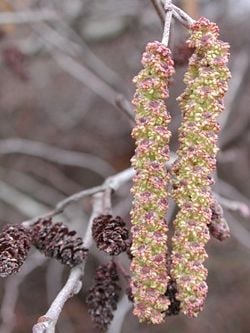
- Hermaphrodite - A plant that has only hermaphrodite reproductive units (flowers, conifer cones, or functionally equivalent structures). In angiosperm terminology a synonym is monoclinous from the Greek "one bed".
- Monoecious - having unisexual reproductive units (flowers, conifer cones, or functionally equivalent structures) of both sexes appearing on the same plant; from Greek for "one household". Individuals bearing flowers of both sexes at the same time are called simultaneously or synchronously monoecious. Individuals that bear only flowers of a single sex at one time are called consecutively monoecious; "protoandrous" describes individuals that function first as males and then change to females; "protogynous" describes individuals that function first as females and then change to males.
- Dioecious - having unisexual reproductive units (flowers, conifer cones, or functionally equivalent structures) occurring on different individuals; from Greek for "two households". Individual plants are not called dioecious: they are either gynoecious or androecious.
- Because many dioecious conifers show a tendency towards monoecy (that is, a female plant may sometimes produce small numbers of male cones or vice versa), these species are termed subdioecious (McCormick & Andresen, 1963).
- In angiosperm terminology, diclinous ("two beds") includes all species with unisexual flowers, although particularly those with only unisexual flowers, i.e. the monoecious and dioecious species.
- Gynoecious - has only female reproductive structures; the "female" plant.
- Androecious - has only male reproductive structures; the "male" plant.
- Gynomonoecious - has both hermaphrodite and female structures.
- Andromonoecious - has both hermaphrodite and male structures.
- Subandroecious - plant has mostly male flowers, with a few female or hermaphrodite flowers.
- Subgynoecious - plant has mostly female flowers, with a few male or hermaphrodite flowers.
- Trimonoecious (polygamous) - male, female, and hermaphrodite structures all appear on the same plant.
Reproduction in amphibians
Both external and internal reproduction are known in amphibians. Anurans utilize mostly external fertilization, while salamanders and caecilians largely reproduce internally.
For the purpose of reproduction, most amphibians are bound to fresh water. A few tolerate brackish water, but there are no true sea water amphibians. Several hundred frog species (e.g., Eleutherodactylus, the Pacific Platymantines, the Australo-Papuan microhylids, and many other tropical frogs), however, do not need any water whatsoever. They reproduce via direct development, an adaptation that has allowed them to be completely independent from freestanding water. Almost all of these frogs live in wet tropical rainforests and their eggs hatch directly into miniature versions of the adult, bypassing the larval tadpole (or "polliwog") stage entirely. Several species have also adapted to arid and semi-arid environments, but most of them still need water to lay their eggs. Symbiosis with single celled algae that live in the jelly-like layer of the eggs is present in a number of species.
Most amphibians go through both an aquatic stage and a terrestrial stage. The amamniotic (shell-less) eggs rely on water in the environment. Upon hatching, amphibian larvae breathe with exterior gills. Many start to transform gradually into the adult's appearance, via a process called metamorphosis. For example, frog larvae (tadpoles) gradually absorb their tail and develop legs for walking on land. The animals then leave the water and become terrestrial adults.
Reproduction in reptiles
Male and female birds and reptiles both have cloacae, an opening through which eggs, sperm, and wastes pass. Intercourse is performed by pressing the lips of the cloacae together, during which time the male transfers his sperm to the female. The female lays amniotic eggs in which the young gestate. Nevertheless, a few species, including most waterfowl and ostriches, have a phallus shaped organ analogous to the mammals' penis.
Most reptiles reproduce sexually. Many male snakes rely on scent to find females, with fertilization being internal.
However, asexual reproduction has been identified in squamates in six families of lizards and one snake. In some species of squamates, a population of females is able to produce a unisexual diploid clone of the mother. This asexual reproduction, called parthenogenesis, occurs in several species of gecko and is particularly widespread in the teiids (expecially Aspidocelis) and lacertids (Lacerta). Parthenogenetic species are also suspected to occur among chameleons, agamids, xantusiids, and typhlopids.
Most reptile species are oviparous (egg-laying). Many species of squamates, however, are capable of giving live birth. This is achieved either through ovoviviparity (egg retention) or viviparity (babies born without use of calcified eggs). Many of the viviparous species feed their fetuses through various forms of placenta, just like mammals (Pianka and Vitt 2003). They often provide considerable initial care for their hatchlings.
Amniotic eggs are covered with leathery or calcareous shells. Amnionic eggs consist of four membranes: (1) the amnion (thin membrane that encloses the amnion fluid within which the embryo rests), (2) the yolk sac (enclosing the yolk, the protein-rich food for the embryo), (3) the allantois (which stores the nitrogenous wastes until hatching), and (4) the chorion (the outer membrane that lines the shell) (Towle 1989). Eggs are waterproof, but permeable to gases. Sperm are placed inside the female by internal fertilization prior to the formation of the shell.
In some reptiles, the sex of the juvenile is determined by the incubation temperature.
Reproduction in birds
Although most male birds have no external sex organs, the male does have two testes which become hundreds of times larger during the breeding season to produce sperm. The female's ovaries also become larger, although only the left ovary actually functions.
In the males of species without a phallus (see below), sperm is stored within the proctodeum compartment within the cloaca prior to copulation. During copulation, the female moves her tail to the side and the male either mounts the female from behind or moves very close to her. He moves the opening of his cloaca, or vent, close to hers, so that the sperm can enter the female's cloaca, in what is referred to as a cloacal kiss. This can happen very fast, sometimes in less than one second.
The sperm is stored in the female's cloaca for anywhere from a week to a year, depending on the species of bird. Then, one by one, eggs will descend from the female's ovaries and become fertilized by the male's sperm, before being subsequently laid by the female. The eggs will then continue their development in the nest.
Many waterfowl and some other birds, such as the ostrich and turkey, do possess a phallus. Except during copulation, it is hidden within the proctodeum compartment within the cloaca, just inside the vent. The avian phallus is purely a copulatory organ and is not used for expelling urine.
After the eggs hatch, parent birds provide varying degrees of care in terms of food and protection. Precocial birds—those that are relatively mature at birth—can care for themselves independently within minutes of hatching. Altricial hatchlings—those born helpless—are blind and naked, and require extended parental care. The chicks of many ground-nesting birds, such as partridges, chickens, and waders, are often able to run virtually immediately after hatching; such birds are referred to as nidifugous. The young of hole-nesters, on the other hand, are often totally incapable of unassisted survival. The process whereby a chick acquires feathers until it can fly is called "fledging."
The three mating systems that predominate among birds are polyandry, polygyny, and monogamy. Monogamy (having one partner for reproduction and raising the young) is seen in approximately 91% of all bird species. Polygyny (one male with more than one female) constitutes 2% of all birds, and polyandry (one female with more than one male) is seen in less than 1%.
Monogamous species of males and females pair for the breeding season. In some cases, the individuals may pair for life. For example, the albatross, bald eagle, and Canadian goose, as well as species of macaws, owls, and crows, mate for life. When the mate dies, there is often a re-mating of the surviving bird. There are instances of one bird showing signs of distress upon the death of a mate, although when the mate is removed from the sight of the survivor, this behavior subsides.
One explanation for the high rate of monogamy among birds is the fact that male birds are just as adept at parental care as females. In most groups of animals, male parental care is rare, but in birds it is quite common; in fact, it is more extensive in birds than in any other vertebrate class. In birds, male care can be seen as important or essential to female fitness. "In one form of monogamy, such as with obligate monogamy, a female cannot rear a litter without the aid of a male" (Gowaty 1983).
The parental behavior most closely associated with monogamy is male incubation. Interestingly, male incubation is the most confining male parental behavior. It takes time and also may require physiological changes that interfere with continued mating. For example, in the case of the emperor penguin, after the female penguin lays its egg, she returns to the sea to feed for two months to replenish her nutritional reserves. During this time, the male incubates the egg in its brood pouch for about two months consecutively without food. If the chick hatches before the mother's return, the father feeds it a substance produced by a gland in his esophagus.
Monogamy does not necessarily translate to fidelity among the pairs, as examples to the contrary are known. It is certainly problematic to compare mating habits of species in creation with human habits, given that people are endowed with a spiritual as well as physical nature. (See human and human body.) Nevertheless, the dominance of monogamy in birds, and the extensive phenomena of pairing for life as a universal standard within certain bird species, provides a counterbalance to the current social Darwinistic views of some that monogamy, pairing for life, and fidelity in humans is an unnatural state. (See reproduction for an elaboration of this perspective.)
Reproduction in mammals
In placental mammals, offspring are born as juveniles: complete animals with the sex organs present although non-functional. After several months or years, the sex organs develop further to maturity and the animal becomes sexually mature. Most female mammals are only fertile during certain periods and during those times, they are said to be "in heat". At this point, the animal is ready to mate. Individual male and female mammals meet and carry out copulation. For most mammals, males and females exchange sexual partners throughout their adult lives.
The mammalian male
Template:Seedetails The male reproductive system contains two main divisions: the penis, which carries the sperm inside it, and the testes, which produce the sperm. In humans, both of these organs are outside the abdominal cavity, but they can be primarily housed within the abdomen in other animals (for instance, in dogs, the penis is internal except when mating). Having the testes outside the abdomen best facilitates temperature regulation of the sperm, which require specific temperatures to survive.
Sperm are the smaller of the two gametes and are generally very short-lived, requiring males to produce them continuously from the time of sexual maturity until death. They are motile and swim by chemotaxis.
The mammalian female
Template:Seedetails The female reproductive system likewise contains two main divisions: the vagina and uterus, which act as the receptacle for the sperm, and the ovaries, which produce the female's ova. All of these parts are always internal. The vagina is attached to the uterus through the cervix, while the uterus is attached to the ovaries via the Fallopian tubes. At certain intervals, the ovaries release an ovum (the singular of ova), which passes through the fallopian tube into the uterus.
If, in this transit, it meets with sperm, the sperm penetrate and merge with the egg, fertilizing it. The fertilization usually occurs in the oviducts, but can happen in the uterus itself. The zygote then implants itself in the wall of the uterus, where it begins the processes of embryogenesis and morphogenesis. When developed enough to survive outside the womb, the cervix dilates and contractions of the uterus propel the fetus through the birth canal, which is the vagina.
The ova are larger than sperm and are generally all created by birth. They are for the most part stationary, aside from their transit to the uterus, and contain nutrients for the later zygote and embryo. Over a regular interval, a process of oogenesis matures one ovum to be sent down the Fallopian tube attached to its ovary in anticipation of fertilization. If not fertilized, this egg is flushed out of the system through menstruation in humans and great apes and reabsorbed in all other mammals in the estrus cycle.
Gestation
Gestation, called pregnancy in humans, is the period of time during which the fetus develops, dividing via mitosis inside the female. During this time, the fetus receives all of its nutrition and oxygenated blood from the female, filtered through the placenta, which is attached to the fetus' abdomen via an umbilical cord. This drain of nutrients can be quite taxing on the female, who is required to ingest significantly higher levels of calories. In addition, certain vitamins and other nutrients are required in greater quantities than normal, often creating abnormal eating habits. The length of gestation, called the gestation period, varies greatly from species to species; it is 38 weeks in humans, 56-60 in giraffes and 16 days in hamsters.
Birth
Once the fetus is sufficiently developed, chemical signals start the process of birth, which begins with contractions of the uterus and the dilation of the cervix. The fetus then descends to the cervix, where it is pushed out into the vagina, and eventually out of the female. The newborn, which is called an infant in humans, should typically begin respiration on its own shortly after birth. Not long after, the placenta is passed as well. Most mammals eat this, as it is a good source of protein and other vital nutrients needed for caring for the young. The end of the umbilical cord attached to the young’s abdomen eventually falls off on its own.
Monotremes
Monotremes, only five species of which exist, all from Australia and New Guinea, lay eggs. They have one opening for excretion and reproduction called the cloaca. They hold the eggs internally for several weeks, providing nutrients, and then lay them and cover them like birds. After less than two weeks the young hatches and crawls into its mother’s pouch, much like marsupials, where it nurses for several weeks as it grows.
Marsupials
Marsupials reproduce in essentially the same manner, though their young are born at a far earlier stage of development than other mammals. After birth, marsupial joeys crawl into their mother’s pouch and attach to a teat, where they receive nourishment and finish developing into self-sufficient animals.
See also
- Asexual reproduction
- Biological reproduction
- Bird
- Flowering plant
- Mammal
- Reptile
- Sex organ
- Sexual intercourse
ReferencesISBN links support NWE through referral fees
- Pang, K. "Certificate Biology: New Mastering Basic Concepts", Hong Kong, 2004
- Journal of Biology of Reproduction, accessed in August 2005.
- Barrett, S. C. H. (2002). The evolution of plant sexual diversity. Nature Reviews Genetics 3(4): 274-284.
- Costich, D. E. (1995). Gender specialization across a climatic gradient: experimental comparison of monoecious and dioecious Ecballium. Ecology 76 (4): 1036-1050.
- Darwin, C. (1877). The Different Forms of Flowers on Plants of the Same Species.
- Dellaporta, S.L. and A. Calderon-Urrea. (1993). Sex determination in flowering plants. The Plant Cell 5: 1241-1251.
- Gowaty, P. A. 1983. Male parental care and apparent monogamy among Eastern Bluebirds (Sialia sialis). The American Naturalist 121(2):149-160.
- Linnaeus, C. (1735). Systema Naturae.
- Molnar, S. (2004). Plant Reproductive Systems, internet version posted February 17 2004.
- Rieger, R., A. Michaelis, and MM. Green (1991). Glossary of Genetics, Fifth Edition. Springer-Verlag. ISBN 0-387-52054-6
- Maynard Smith, J. 1978. The Evolution of Sex. Cambridge University Press. ISBN 0-521-29302-2.
- McGraw-Hill (Publisher). 2004. McGraw-Hill Concise Encyclopedia of Science and Technology, 5th Edition. McGraw Hill Professionals. ISBN 0071429573.
- Otto, S. P., D. B. Goldstein. 1992. Recombination and the evolution of diploidy. Genetics 131: 745-751.
- Tobler, M., and I. Schlupp. 2005. Parasites in sexual and asexual mollies (Poecilia, Poeciliidae, Teleostei): a case for the Red Queen? Biol. Lett. 1(2): 166-168.
Credits
New World Encyclopedia writers and editors rewrote and completed the Wikipedia article in accordance with New World Encyclopedia standards. This article abides by terms of the Creative Commons CC-by-sa 3.0 License (CC-by-sa), which may be used and disseminated with proper attribution. Credit is due under the terms of this license that can reference both the New World Encyclopedia contributors and the selfless volunteer contributors of the Wikimedia Foundation. To cite this article click here for a list of acceptable citing formats.The history of earlier contributions by wikipedians is accessible to researchers here:
The history of this article since it was imported to New World Encyclopedia:
Note: Some restrictions may apply to use of individual images which are separately licensed.
